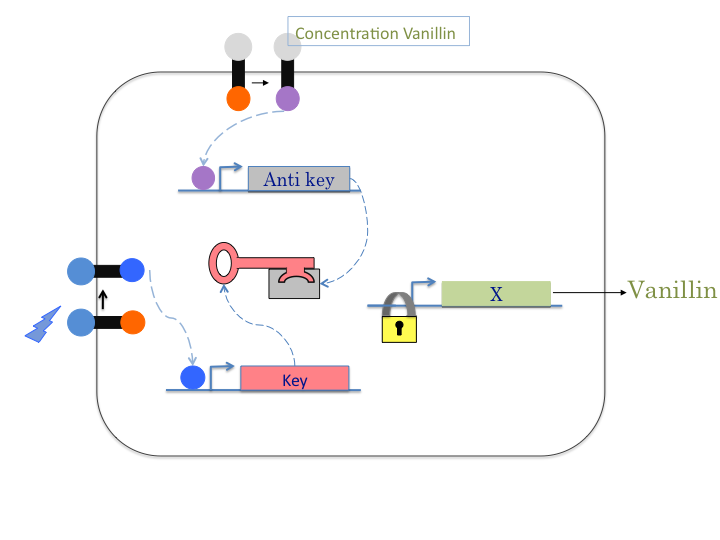Team:KULeuven/Project
From 2009.igem.org
(→Vanilla Perfume, the story of a control bacterium) |
(→Vanilla synthesis) |
||
| Line 19: | Line 19: | ||
This concept can also be applied to other odours or even flavours. In theory, any molecule that acquires a constant value is a possible candidate. | This concept can also be applied to other odours or even flavours. In theory, any molecule that acquires a constant value is a possible candidate. | ||
| - | === | + | === Vanillin synthesis === |
To produce the odour of Vanilla, Essencia coli synthesises Vanillin, which easily diffuse out of the cel. This molecule is derived from the amino acid tyrosine, in a process involving five enzymes. The successive transcription and translation of ''Sam8, Sam5'', COMT, ''fcs, ech'' leads to Vanillin production, which then diffuses out of the cell. | To produce the odour of Vanilla, Essencia coli synthesises Vanillin, which easily diffuse out of the cel. This molecule is derived from the amino acid tyrosine, in a process involving five enzymes. The successive transcription and translation of ''Sam8, Sam5'', COMT, ''fcs, ech'' leads to Vanillin production, which then diffuses out of the cell. | ||
Revision as of 11:15, 3 September 2009
Vanilla Perfume, the story of a control bacterium
‘Essencia coli’ is a vanillin producing bacterium equipped with a control system that keeps the concentration of vanillin at a constant level. The showpiece of the project is the feedback mechanism. Vanillin synthesis is initiated by irradiation with blue light. The preferred concentration can be modulated using the intensity of that light. At the same time the bacterium measures the amount of vanillin outside the cell and controls its production to maintain the set point. The designed system is universal in nature and has therefore potential benefits in different areas. The concept can easily be applied to other flavours and odours. In fact, any application that requires a constant concentration of a molecular substance is possible.
How it works...
Feedback control system
The novelty of this project is a unique control system that functions through a feedback mechanism. The desired value of an odour like Vanilla can be adjusted using the intensity of a blue light beam. Essencia coli then senses the concentration of the odour molecule and activates the inhibition mechanism of an anti-key. In this way the concentration can be kept constant at any initial set point.
This concept can also be applied to other odours or even flavours. In theory, any molecule that acquires a constant value is a possible candidate.
Vanillin synthesis
To produce the odour of Vanilla, Essencia coli synthesises Vanillin, which easily diffuse out of the cel. This molecule is derived from the amino acid tyrosine, in a process involving five enzymes. The successive transcription and translation of Sam8, Sam5, COMT, fcs, ech leads to Vanillin production, which then diffuses out of the cell.
Blue Light
A key/lock mechanism opens the door to synthesis. The transcription of the 'key' gene commences when the blue light receptor absorbs a photon of blue light, thereby activating the promotor. The intensity of the light can be adjusted at will. The 'key' mRNA ("A") then interacts with the 'lock' and clears the road for RNA Polymerase to transcribe the locked genes.
VirA/VirG Vanillin Receptor
Essencia coli is equipped with the two component regulatory system VirA/VirG, derived from Agrobacterium tumefaciens. The VirA protein senses phenolic compounds -in this case Vanillin- and then transduces the signal through phosphate transfer to the VirG protein. VirG acts as a response regulator by binding to the upstream region of the anti-key gene and activating its transcription. The anti-key ("B") is the anti-sense mRNA of the key and will therefore block it after binding.
Key and antikey
When the antikey is present, it will bind the key with such great affinity that a complex antikey+key occurs. So, the more Vanillin is produced, the more of the anti-key will be transcribed and will bind to key. The bound complex of key and anti-key puts a stop to the synthesis of vanillin.
 "
"
